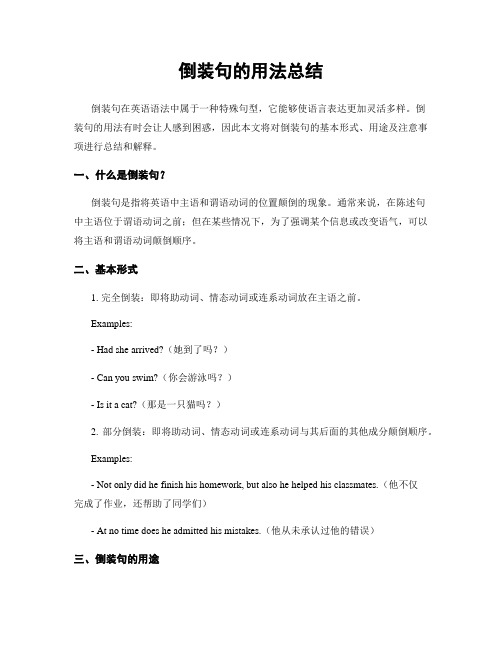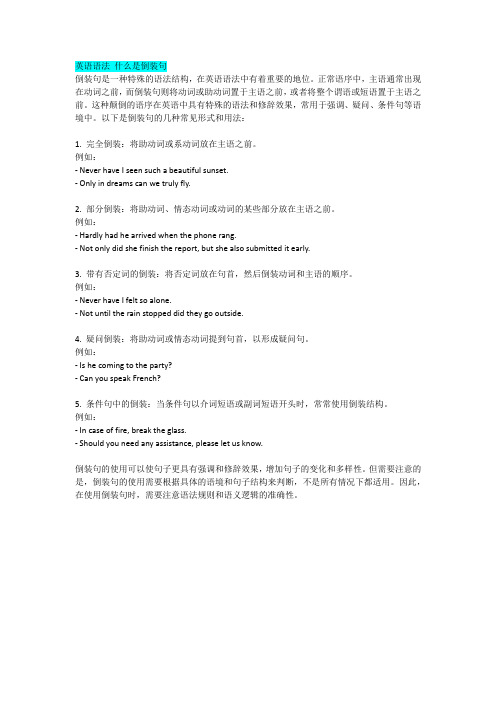倒装句语法讲解
- 格式:doc
- 大小:23.50 KB
- 文档页数:2

倒装句的用法总结倒装句在英语语法中属于一种特殊句型,它能够使语言表达更加灵活多样。
倒装句的用法有时会让人感到困惑,因此本文将对倒装句的基本形式、用途及注意事项进行总结和解释。
一、什么是倒装句?倒装句是指将英语中主语和谓语动词的位置颠倒的现象。
通常来说,在陈述句中主语位于谓语动词之前;但在某些情况下,为了强调某个信息或改变语气,可以将主语和谓语动词颠倒顺序。
二、基本形式1. 完全倒装:即将助动词、情态动词或连系动词放在主语之前。
Examples:- Had she arrived?(她到了吗?)- Can you swim?(你会游泳吗?)- Is it a cat?(那是一只猫吗?)2. 部分倒装:即将助动词、情态动词或连系动词与其后面的其他成分颠倒顺序。
Examples:- Not only did he finish his homework, but also he helped his classmates.(他不仅完成了作业,还帮助了同学们)- At no time does he admitted his mistakes.(他从未承认过他的错误)三、倒装句的用途1. 当以否定词开头表达“部分否定”的意思时,常常使用完全倒装。
Example:- Never have I seen such a beautiful sunset.(我从未见过如此美丽的日落)2. 在虚拟条件句中,通常采用部分倒装。
Example:- Should you need any assistance, please let me know.(如果你需要任何帮助,请告诉我)3. 在介词短语置于句首时,为了避免重复或强调信息,可以使用完全或部分倒装。
Examples:- Off the table fell a plate.(桌子上掉下了一只盘子)- Into the room walked a toddler and her mother.(一个蹒跚学步的小孩和她的妈妈走进了房间)四、注意事项1. 只有助动词、情态动词和连系动词才能发生倒装。

高考英语语法复习倒装句知识讲解定义:谓语或谓语的一部分放在主语之前。
分类:完全倒装和部分倒装两大类。
完全倒装指整个谓语放在主语之前部分倒装指助动词、情态动词或be动词等放在主语之前一、完全倒装1.there be 句型there 也可以接appear, seem, stand, exist, lie, remain, live 等词There stands a tree in front of our class.There lies a river in front of my house.2.表示方位或时间的副词或介词短语如:now, then, here, there , then, up, down, in, away, out, in the room 等置于句首,且主语是名词时Now comes your turn.In front of my house lies a river.There goes the bell.Out rushed the students.注意: 如果主语是人称代词不倒装Here we are.Out they rushed.二、部分倒装1.否定意义的副词或连词放句首时如:no, not, never, seldom, little, hardly, nowhere, at no time, in no case, by no means, on no condition, in no way, under/in no circumstances等Never have I seen such a moving film.By no means will you find the key to the question on the Internet.2.only修饰副词、介词短语或从句作状语放在句首时Only in this way can we learn English well.Only then did she realize the importance of learning English.Only when he is ill, does he know how important health is.注意:only 修饰主语时, 句子不倒装Only can he tell the truth.(x)Only he can tell the truth.(√)3.Not until “直到”放句首时Not until he took off his sunglasses did I recognize him.Not until I began to work, did I realize how much time I had wasted.4.not only…but also “不仅…而且”放句首时Not only does he work hard but also he is willing to help others.Not only is he my English teacher, but also he is my friend.5.neither..., nor...“…不…, …也不…”Neither do I know it, nor do I care about it.6.no sooner...than, hardly/scarcely...when “一...就”Hardly had he arrived when the train left.No sooner had she gone than the traffic accident happened.7.“so+adj./adv.+ that...和“such+(a/an+) adj.+n.+ that...句型中, “so或such”放句首时So excited was he that he could not say a word.Such a good job has he done that we all admire him.8.“so + be 动词/ 助动词/ 情态动词 + 主语”用于对前面所说的肯定内容也适用于后者,表示“也”He is kind and helpful, so is she.I like English, so does he.They can speak English well, so can she.区分:He is kind and helpful, so he is.(不倒装表示“确实”)I like English, so I do.They can speak English well, so they can.9."neither/nor + be 动词/ 助动词/ 情态动词 + 主语”用于对前面所说的否定内容也适用于后者,表示“也不”He isn’t kind and helpful, neither/nor is she.I don’t like English, neither/nor does he.I can’t speak English well, neither/nor can she.注意:如果前面所说的内容既有肯定又有否定,或前后的谓语动词形式不一致时,则用结构“It is the same with +主语”或“So it is with +主语”I worked hard, but didn't pass the exam.So it was with my friend Lucy.10.as/though引导的让步状语从句结构 n./ adj./ v./ adv.+ as / though + 主语 + 谓语Child as he is, he knows a lot.(child 前不加冠词)Young as he is, he knows a lot.Try as he might, he failed.Much as I like Beijing, I can’t live there.11.频率的副词(often, many a time 等)放句首时Many a time has he made the same mistake.Often does he make the same mistake.12.虚拟语气if 引导的条件状语从句Were I you, I would work harder.Had you followed my advice, you would have passed the exam.Should it rain tomorrow, I would stay at home.13.某些表示祝愿的句子May you be happy!May your future become prosperous.。

英语语法什么是倒装句倒装句是一种特殊的语法结构,在英语语法中有着重要的地位。
正常语序中,主语通常出现在动词之前,而倒装句则将动词或助动词置于主语之前,或者将整个谓语或短语置于主语之前。
这种颠倒的语序在英语中具有特殊的语法和修辞效果,常用于强调、疑问、条件句等语境中。
以下是倒装句的几种常见形式和用法:1. 完全倒装:将助动词或系动词放在主语之前。
例如:- Never have I seen such a beautiful sunset.- Only in dreams can we truly fly.2. 部分倒装:将助动词、情态动词或动词的某些部分放在主语之前。
例如:- Hardly had he arrived when the phone rang.- Not only did she finish the report, but she also submitted it early.3. 带有否定词的倒装:将否定词放在句首,然后倒装动词和主语的顺序。
例如:- Never have I felt so alone.- Not until the rain stopped did they go outside.4. 疑问倒装:将助动词或情态动词提到句首,以形成疑问句。
例如:- Is he coming to the party?- Can you speak French?5. 条件句中的倒装:当条件句以介词短语或副词短语开头时,常常使用倒装结构。
例如:- In case of fire, break the glass.- Should you need any assistance, please let us know.倒装句的使用可以使句子更具有强调和修辞效果,增加句子的变化和多样性。
但需要注意的是,倒装句的使用需要根据具体的语境和句子结构来判断,不是所有情况下都适用。
因此,在使用倒装句时,需要注意语法规则和语义逻辑的准确性。

倒装句语法一、倒装句的定义倒装句是一种语法结构,将句子中的谓语动词、助动词或情态动词等提到主语之前,这种语序与正常的主语在前、谓语在后的语序不同。
二、倒装句的类型1. 完全倒装- 定义- 当句子中的谓语动词全部置于主语之前时,称为完全倒装。
- 常见情况- 表示方位、地点的副词或介词短语位于句首时,如:- There goes the bell.(铃响了。
)- Here comes the bus.(公共汽车来了。
)- In front of the house stands a big tree.(房子前面有一棵大树。
)- 表语位于句首时,为了保持句子平衡或强调表语,如:- Present at the meeting were some famous scientists.(出席会议的是一些著名的科学家。
)2. 部分倒装- 定义- 当句子中的助动词、情态动词或be动词提到主语之前,而谓语的主要部分仍在主语之后时,称为部分倒装。
- 常见情况- 否定词或半否定词位于句首时,如:- Never have I seen such a beautiful place.(我从未见过如此美丽的地方。
)- Hardly had he arrived when it began to rain.(他刚到就开始下雨了。
)- only +状语(副词、介词短语、从句)位于句首时,如:- Only in this way can you solve the problem.(只有这样你才能解决这个问题。
)- Only when he returned did we find out the truth.(只有当他回来时我们才发现真相。
)- so/neither/nor位于句首,表示前面所说的情况也适用于另一人或物时,如:- He likes reading, so do I.(他喜欢阅读,我也喜欢。
)- He didn't go to the party, neither did I.(他没去参加聚会,我也没去。

倒装句语法知识点归纳总结倒装句是英语中的一种句法结构,与普通句序不同,将谓语动词或助动词放在主语之前,从而改变了句子的语序。
倒装句在表达强调、修辞、疑问和条件等方面起到重要的作用。
本文将对倒装句的基本结构、分类、用法和注意事项进行总结和归纳。
一、倒装句的基本结构1. 完全倒装句:将谓语动词或助动词完全放在主语之前。
例:In the garden stood a beautiful flower.Behind the house lies a large garden.2. 部分倒装句:将助动词、情态动词或系动词放在主语之前。
例:He can speak three languages.Never have I seen such a beautiful sunset.二、倒装句的分类1. 谓语倒装句:将谓语动词完全或部分地放在主语之前。
例:She is coming. -> Is she coming?He has never been to Japan. -> Never has he been to Japan.2. 状语倒装句:将表示地点、时间、方向、原因、条件等的状语放在句首,主语和谓语动词保持原来的顺序。
例:Away went the train.In the distance could be seen a tall tower.3. 主从倒装句:主句和从句中的主语-谓语结构进行倒装。
例:Not until she finished her homework did she go to bed.Only when the rain stopped could we go outside.三、倒装句的用法1. 强调句:通过倒装句,可以将句子的某一部分进行强调,常用的结构是完全倒装句和部分倒装句。
例:Not only did he win the game, but he also broke the record.Under no circumstances should you touch the red button.2. 疑问句:直接将谓语动词或助动词放在主语之前形成疑问句。

倒装句讲解什么是倒装句?倒装句是英语中一种语法结构,常用于强调句子的某个成分、改变语序或与上下文形成对比。
正常的语序是主语在前,谓语动词在后,而倒装句则将谓语动词或助动词置于主语之前,从而形成倒装的结构。
倒装句在英语中使用较为频繁,掌握倒装结构对于理解和运用英语句子具有重要意义。
倒装句的分类根据倒装的形式和用途,倒装句可以分为以下几种类型:1.完全倒装句:将整个谓语动词或助动词短语置于主语之前,没有任何修饰成分。
例子:Up flew the birds at the sound of the gunshot.(枪声一响,鸟儿们立刻飞起来了。
)2.部分倒装句:只将谓语动词的一部分(常为助动词或情态动词)置于主语之前。
例子:Never have I seen such a beautiful sunset before.(我以前从未见过如此美丽的日落。
)3.介词短语倒装句:在以介词短语引导的状语从句或时间、地点状语前,将主谓语倒装。
例子:In the garden sat a little girl, lost in her own thoughts.(花园里坐着一个小女孩,陷入了自己的思考。
)倒装句的用法倒装句的主要用途有以下几种:1.强调句子的某个成分:通过倒装结构将被强调的成分置于句首,使其更加突出。
例子:Only in this way can we achieve our goals.(只有通过这种方式,我们才能实现我们的目标。
)2.改变语序:某些表示否定、半否定或者只有部分意义的词语或短语需要使用倒装句来构成正确的语序。
例子:On no condition should you touch the red button.(无论如何你都不能碰那个红色按钮。
)3.与上下文形成对比:有时候为了与上文形成对比,需要使用倒装结构。
例子:John went by bus, while his sister went by train.(约翰坐公共汽车去了,而他的姐姐则乘火车去了。
关于倒装句的英语语法解析倒装句是英语语法中的一种,常用语书面结构,下面就是我给大家带来的关于倒装句的英语语法解析,盼望能关心到大家!倒装句之全部倒装全部倒装是只将(句子)中的谓语动词全部置于主语之前。
此结构通常只用与一般现在时和一般过去时。
常见的结构有:1)here, there, now, then, thus等副词置于句首,谓语动词常用be, come, go, lie, run。
There goes the bell.Then came the chairman.Here is your letter.2)表示运动方向的副词或地点状语置于句首,谓语表示运动的动词。
Out rushed a missile from under the bomber.Ahead sat an old woman.留意:上述全部倒装的句型结构的主语必需是名词,假如主语是人称代词则不能完全倒装。
Here he comes.Away they went.14.2 倒装句之部分倒装部分倒装是指将谓语的一部分如助动词或情态倒装至主语之前。
假如句中的谓语没有助动词或情态动词,则需添加助动词do, does或did,并将其置于主语之前。
1)句首为否定或半否定的词语,如no, not, never, seldom, little, hardly, at no time, in no way, not until 等。
Never have I seen such a performance.Nowhere will you find the answer to this question.Not until the child fell asleep did the mother leave the room.当Not until引出主从复合句,主句倒装,从句不倒装。
留意:如否定词不在句首不倒装。
I have never seen such a performance.The mother didnt leave the room until the child fell asleep.典型例题1)Why cant I smoke here?At no time___ in the meeting-roomA. is smoking permittedB.smoking is permittedC. smoking is it permittedD.does smoking permit答案A. 这是一个倒装问题。
倒装句一、概述:英语中基本的词序通常都是主语在谓语动词的前面,宾语、表语和补语在谓语动词的后面。
但有时可以改变这种正常词序,把谓语放在主语的前面,这叫倒装。
如果将谓语动词全部移到主语的前面,叫做完全倒装;如果只是把助动词或情态动词放在主语的前面,就叫部分倒装。
二、倒装的目的:1. 语法要求: 疑问句, there be, 祝愿句;2. 修辞要求: 为了强调;为描写生动;为衔接上下文;为平衡句子.三、倒装的类别:倒装其实很好记,记住“闹事”(NAO SHI)就可以。
说明:NAO SHI中的六个字母代表六种情况。
1. N代表否定词。
当否定词置于句子开头时,句子要用部分倒装。
这些否定词有no, little, seldom, never, not until, not only, neither, nor, hardly, no sooner等词。
如:Little does he know about it.Hardly had he arrived there when it began to rain.Not only can he speak English, but also he can write articles in English.2. A代表as。
as (尽管) 引导让步状语从句时,从句要用倒装语序。
如:Fail as he did, he didn’t lose heart.Child as my younger brother is, he knows a lot.3. O代表only。
only修饰状语置于句首时,句子要用部分倒装。
如:Only in a strange place did he realize how good his home is.Only when you grow up will you understand me.4. S代表so和such。
当“so…that..”和“such…that…”结构中的so和such位于句首或so表示“也”的时候,句子用倒装语序。
中考英语语法知识讲解一、倒装句(一)倒装定义出于语法和修辞目的(强调,承上启下,平衡等)的需要,把谓语的一部分或全部句子的其他成分放在主语之前,叫倒装语序。
(二)倒装句的种类①完全倒装提前部分+谓语动词+主语。
②部分倒装提前部分+助动词+主语+谓语相当于提前部分+一般疑问句。
③形式倒装只把强调的内容提至句首,主谓并不倒装。
1.部分倒装在现实的语言实践中,由于语法结构的要求,或是由于修辞的需要,往往要改变句子的自然语序,把一些本应置于主语之后的句子成分提到主语之前,我们称这种语序的变化为“倒装语序”。
下面我们就来看一下倒装句中的部分倒装。
在出现以下情况时,需要使用部分倒装:情况一:only修饰的状语(副词、介词短语或状语从句)位于句首;如:Only after three operations was he able to walk.做过三次手术之后,他才能行走。
值得注意的是,当only修饰主语时,则不倒装。
如:Only that girl knew how to work out the problem.只有那位女生知道怎样解那道题。
情况二:含有否定意义的副词(never, seldom, little, few, not, nowhere等)位于句首;如:Seldom in all my life have l met such a brave man.我一生很少见过这么勇敢的人。
Little did he realize the danger he faced.他几乎没有认识到他面临的危险。
情况三:so/neither/nor开头的句子,说明前面的内容也适用于后者时,用倒装句“so/neither/nor+be/have/助动词/情态动词+主语”。
如:John can't speak Japanese, nor can Helen.约翰不会讲日语,海伦也不会。
情况四:not only...(but also)...位于句首引导两个分句时,前一个分句中的主谓要采用部分倒装,第二个分句则不倒装。
倒装句
倒装是需要表示一定句子结构和强调某一句子成分时所采取的一种句子手段。
注意我们经常总结的英语中的倒装主要是主谓结构的倒装,将主语和谓语完全颠倒过来为完全倒装,只将助动词或情态动词等移至主语之前,则称为部分倒装。
一、完全倒装
1.表示地点,时间的副词放在句首时,句子需要完全倒装,此类副词常见的有:here, there, now, then, up, down, out等
Eg. Here comes the bus.
There stands an old tree.
Now comes your turn.
*注意如果主语是代词,则无需倒装,如第一个例句的主语不是bus而是it,则必须说:Here it comes.
2.表示时间,地点,方向等的介词短语放句首时,完全倒装:
Eg. In front of the village runs a river.
On the top of the building flies a flag.
3.分词短语置于句首时全部倒装:
Eg. Lying on the floor was a boy aged about 12.
Seated in the front were the guests.
4.主系表结构中,表语前置,完全倒装:
Eg. Present at the meeting were experts on biology.
The lecture he prepared was long and boring. 可全倒装为:Long and boring was the lecture he prepared.
5.There be句型为全部倒装。
二.部分倒装(半倒装)
1.疑问句中的部分倒装:
·一般疑问句中,我们都可以很明显的看到助动词或者be动词被提前到了主语前面:Have you finished your work?
Do you like reading?-
Are you crazy?
·特殊疑问句中助动词也提至主语前,但要放在疑问词之后:
Where did you live in the past?
2.Only+状语/状语从句位于句首时,主句中的主语和谓语要部分倒装:
Only+状语: Only in this way can you solve this problem.
Only+状语从句: Only after you experience the same things will you understand your sister.
3.表示否定意义的副词和连词放在句首时需要部分倒装结构。
常见的此类副词连词有:not,little, never, hardly, rarely, scarcely, no sooner...than, hardly...when, not only...but also, not until, by no means, in no case, seldom等。
Eg. 1). Never shall I do the same thing again.
2). Not until结构中只倒装主句,until从句不到装,但是随until一起提前:Not until the teacher entered the classroom did we stopped talking.
而原句应为:We did not stop talking until the teacher enter the classroom.
3). Not only...but also结构中,将not only置于句首时,只倒装not only引导的句子,but also不倒装:Not only can he speak Chinese, but he is also good at writing Chinese poems.
4). No sooner had I got home than it began to rain. 我刚到家就开始下雨。
4.So...that...(如此...以至于...)句型中,so...部分位于句首时部分倒装,但that部分不受影响:So carelessly did he drive that he almost killed himself.
So fast do you speak that I can hardly follow you.
5.虚拟条件句中省略“if”,则从句部分需要半倒装。
如:
·If I were you, I would work harder.----> Were I you, I would word harder.
·If you had come to my birthday party last night, you would have met my brother John.---> Had you come to my birthday party last night, you would have met my brother John.
6.表示后者情况与前者情况一致的“so do I”及“neither do I”句型中的部分倒装是一望而知的,注意提至主语前的助动词,情态动词和be动词需要注意时态或者主谓一致等情况:·I’ ve been to Norway before and so has my sister.
·I couldn’t answer my teacher’s question. Neither/ Nor could Peter.
7.“May”置于句首表示祝愿构成半倒装:
May you succeed!
May you have a good trip!。